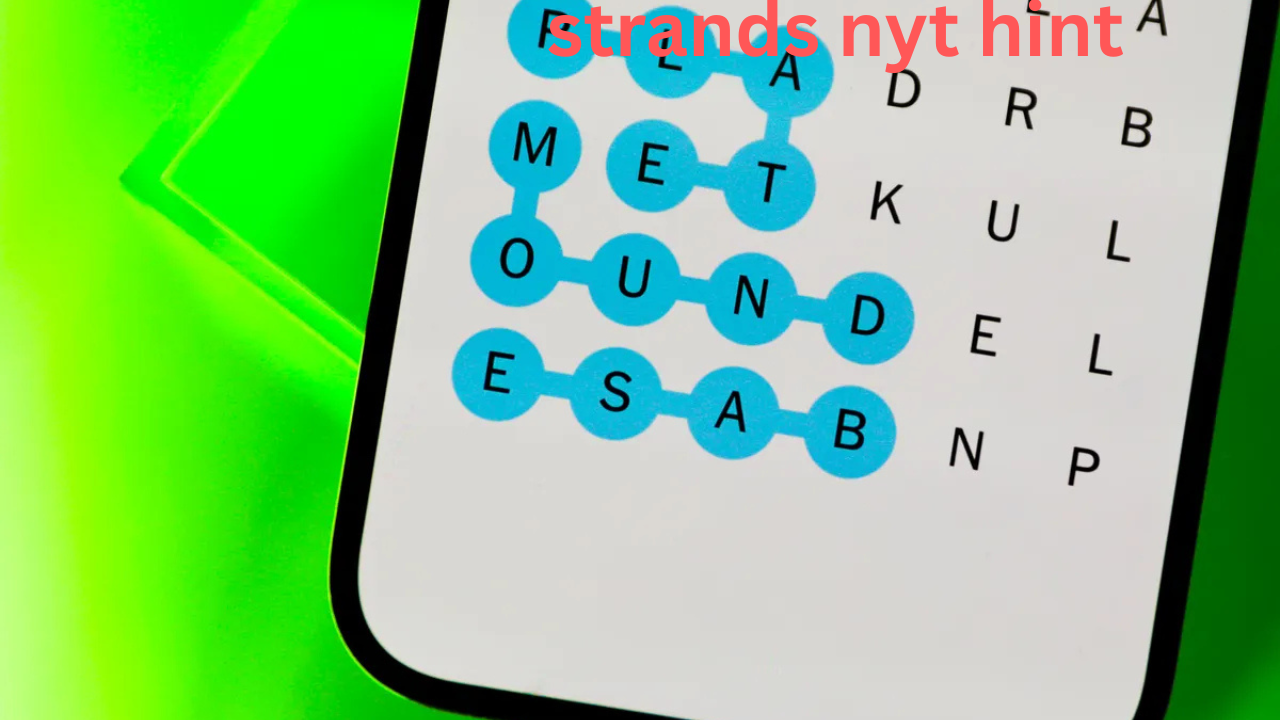Decoding the Strands NYT Hint A Comprehensive Guide to Understanding the Puzzle
The world of puzzles, particularly those found in The New York Times (NYT), holds a special place in the hearts of enthusiasts. Among these puzzles, the Strands puzzle stands out for its unique challenge and the reliance on hints to solve it. Whether you’re a seasoned solver or just starting out, understanding how to approach the “Strands NYT hint” can significantly enhance your experience and help you improve your puzzle-solving skills. In this guide, we’ll break down the Strands puzzle, explain the role of hints, and provide you with strategies to tackle even the most difficult clues.
Introduction: What is the Strands NYT Hint?
The Strands puzzle is a relatively recent addition to The New York Times puzzle lineup, offering an engaging twist on the classic crossword. The puzzle is known for its unique structure, which features clues that are not always straightforward and often require the solver to think outside the box. The “Strands NYT hint” is an essential part of this puzzle, designed to guide players through the most challenging aspects of the game.
Hints in the Strands puzzle can come in many forms. They may be straightforward word clues, visual cues, or more cryptic suggestions that require a deeper level of thought. The primary purpose of these hints is to help solvers who may be stuck or need a nudge in the right direction. However, the balance between using hints and relying on your own problem-solving abilities is crucial—overusing hints can take away from the satisfaction of solving the puzzle on your own. Understanding when and how to use hints effectively is key to mastering the Strands puzzle.
The Basics of the Strands Puzzle
To truly understand how hints work in the Strands puzzle, it’s essential to grasp the structure of the puzzle itself. The Strands puzzle is a word-based puzzle that often blends traditional crossword-style clues with more abstract or visual elements. The format typically includes a grid of blank spaces where the solver must fill in the correct words based on the provided clues. However, the clues in the Strands puzzle are not always simple definitions. Instead, they may include wordplay, puns, or indirect hints that challenge your creativity.
The puzzle might also include visual clues, such as images, patterns, or symbols, which add an extra layer of complexity. Solvers are encouraged to think in multiple dimensions when approaching the puzzle, considering not only the literal meanings of the words but also their relationships, word structures, and patterns. This dual approach—word-based and visual—makes the Strands puzzle unique and particularly enjoyable for those who love a challenge.
The key to solving the Strands puzzle is to start by filling in the easiest clues first. These are often straightforward definitions or clues that you can solve based on your knowledge. As you begin to solve these, you’ll start to uncover more letters, making it easier to guess the more difficult clues. If you encounter a particularly tricky clue, don’t hesitate to use hints. But remember, the most satisfying puzzle-solving experiences come from making connections on your own.
Understanding the Role of Hints in Strands Puzzles

Hints play an essential role in the Strands puzzle, particularly for solvers who find themselves stuck or unsure of the next step. The NYT’s Strands puzzle often includes hints that provide additional information or nudge you in the right direction. Understanding the different types of hints and how to use them effectively can greatly enhance your puzzle-solving abilities.
There are two primary types of hints in the Strands puzzle: direct and indirect. Direct hints are straightforward suggestions that help solve a specific clue. For example, a hint might suggest a synonym for the answer or point to a particular letter in the word. These hints are often helpful for solving more complex clues but should be used sparingly to maintain the puzzle’s challenge.
Indirect hints, on the other hand, require a bit more creativity to interpret. These hints may come in the form of a visual element, a subtle wordplay, or a cryptic message that encourages solvers to think beyond the obvious answer. These types of hints can be especially tricky but also incredibly rewarding when deciphered correctly. Learning to recognize these indirect hints is a crucial skill for becoming proficient at the Strands puzzle.
The key to using hints effectively is balance. Hints should be seen as a tool to help you when you’re stuck, not as a crutch that prevents you from thinking through the clues on your own. A good solver knows when to push through a challenging clue and when to seek a hint for guidance.
Common Mistakes and Pitfalls in Solving Strands Puzzles
Even experienced puzzle solvers can fall into certain traps when tackling the Strands NYT hint puzzle. There are a few common mistakes that can hinder your progress, and recognizing these pitfalls is essential for improving your solving skills.
One of the most frequent errors is overcomplicating the puzzle. Solvers often try to read too much into a clue, attempting to decipher overly complex meanings or trying to fit in obscure words. This can lead to confusion and frustration. The best approach is to start simple. Look at the clue for its most basic meaning and work from there. The simplest answer is often the correct one.
Another common mistake is ignoring simple hints or clues. Sometimes, a hint is exactly what you need to move forward, but solvers may overlook it because they feel it’s too obvious or not challenging enough. Don’t underestimate the value of a straightforward hint—sometimes the easiest solution is the one that gets you unstuck.
Lastly, getting stuck in a pattern is another pitfall that many solvers experience. Once you start solving a few clues, it can be easy to follow a particular line of thinking. However, this can lead to a dead end if the clues you’re solving are actually pointing in a different direction. It’s important to remain flexible and open-minded when solving the puzzle. If you hit a roadblock, try approaching the clues from a different angle.
Advanced Strategies for Mastering Strands NYT Hints
As with any puzzle, there’s always room for improvement. For those looking to take their Strands NYT hint-solving skills to the next level, there are several advanced strategies to consider.
One key approach is learning to break down more cryptic or abstract hints. Often, these hints require you to focus on wordplay, such as homophones, anagrams, or double meanings. Practice identifying these types of clues and becoming familiar with common puzzle conventions. This will allow you to approach the puzzle with greater confidence and solve more complex clues.
Another advanced strategy is recognizing patterns within the puzzle itself. As you solve more Strands puzzles, you’ll begin to notice recurring themes or types of clues. For example, certain letters or combinations of words may appear frequently in specific positions. These patterns can give you insight into how to approach similar puzzles in the future.
Lastly, improving your knowledge base will also help you tackle more difficult hints. Expanding your vocabulary, keeping up with current events, and reading more widely can provide you with the background knowledge needed to solve even the most obscure clues. The more you know, the easier it will be to recognize the answer when a hint presents itself.
Conclusion: Becoming a Strands NYT Hint Expert
Mastering the Strands NYT hint puzzle takes practice, patience, and a strategic approach. Understanding the puzzle’s structure, the different types of hints, and how to use them effectively is essential for becoming proficient at solving these challenges. Whether you’re a beginner or an advanced solver, applying the right strategies will allow you to navigate the puzzle with ease and satisfaction .The Strands puzzle is designed to push your limits and reward your creativity. By practicing regularly and honing your skills, you’ll soon find yourself becoming an expert at decoding the hints and solving the puzzle efficiently. Enjoy the process, and remember that every solved puzzle brings you one step closer to becoming a Strands NYT hint master.
FAQs
What is the Strands NYT hint puzzle?
The Strands NYT hint puzzle is a word-based puzzle featured in The New York Times. It includes a combination of word-based clues, visual elements, and indirect hints that challenge solvers to think creatively.
How do I start solving the Strands puzzle?
Start with the easiest clues to build momentum. As you fill in the answers, more letters will be revealed, helping you solve the more difficult clues.
Are there any tips for beginners?
Begin by focusing on simple definitions, and don’t hesitate to use hints when needed. Look for patterns in the puzzle to help guide you.
What are some common mistakes to avoid when solving Strands puzzles?
Avoid overcomplicating clues, ignoring simple hints, and getting stuck in a pattern. Stay flexible and think creatively.
How can I improve my skills for solving hints?
Practice regularly, learn to recognize cryptic and indirect hints, and expand your knowledge base to improve your clue-solving abilities.
You May Also Read: https://networkinfonews.com/nyt-connections-hint/














Post Comment